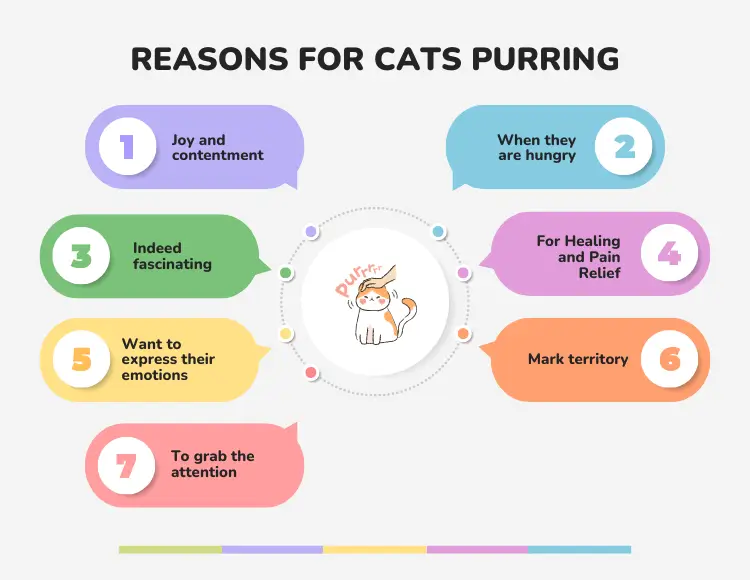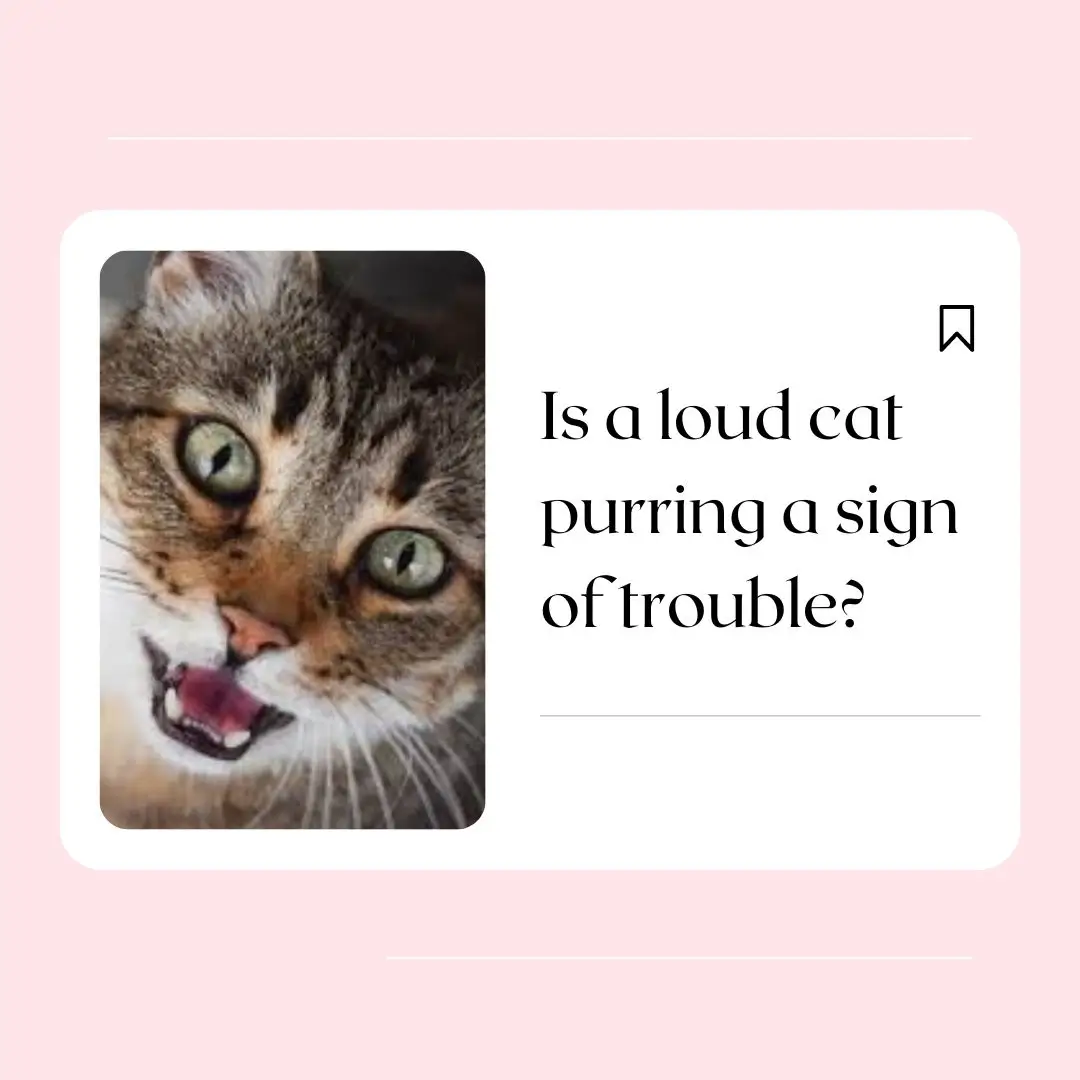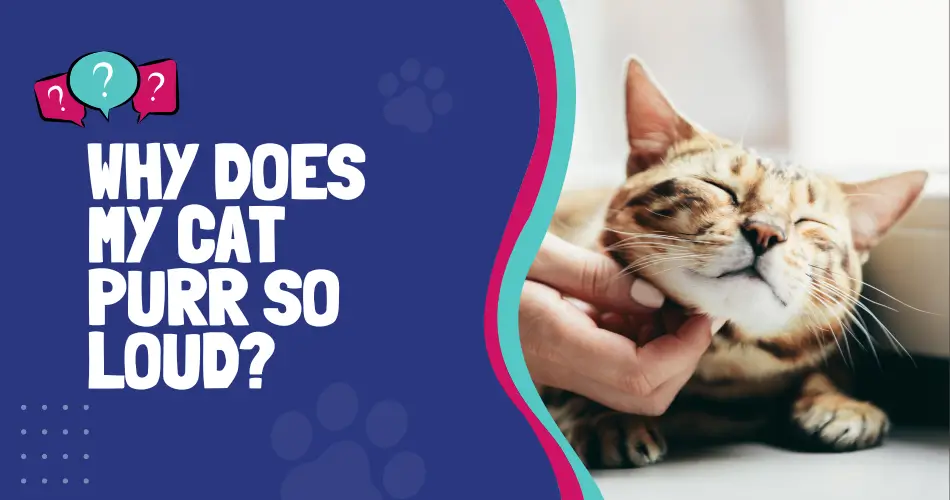Have you ever wondered why sometimes your cat purrs so loudly? Cats are dynamic creatures, and many times they behave differently and have distinct personality traits from one another.
Assistant Professor Dr. Sarah Guess, from the American College of Veterinary Internal Medicine, confirms that cats purr when they are stressed or feeling content. She emphasizes that the real reason for purring remains hotly debated among scientists.
Cats are one of those domesticated creatures that we all love to care for. According to a recent study, COVID-19 led to a 40% increase in cat ownership throughout the USA. These new cat parents worry and stress about why their cats purr so loudly.
How (And Why) Do Cats Purr?

Purring is a behavior that starts in kittens shortly after their birth. Purring starts in the form of communication between the mother and her kittens, indicating their presence and well-being. As cats grow older, this behavior persists and evolves into a method of communicating with their human families as well.
Dr. Oscar E. Chavez, a renowned veterinary specialist from the UK’s Royal Veterinary College, University of London, states that purring is caused by the vibration of a cat’s vocal cords. This happens due to the flexing of the cat’s larynx and diaphragm muscles as they breathe in or out. The resulting sound has a sweet and distinct quality, ranging from 25 hertz to 150 hertz.
To understand the type of emotion, you will have to take a look at other cues, i.e., body language, or even in social settings, to understand why cats are purring.
In the article below, we have tried to summarize why cats can purr so loudly.
1. The Primary Reason Behind a Cat’s Purring
Many cat owners agree that the primary reason behind cat purring is to express joy and contentment. According to a comment on Quora, Dr. Jules, a professional psychologist, says:
‘’When a cat is happy or relaxed, they will often purr as a way to signal that they are feeling calm and content.’’
When your furry friend is calm, relaxed, and receiving your attention while you stroke their sweet spot, they will often purr loudly. It is usually a positive sign of feeling content and expressing their emotions.
2. Demands for Food through Purr
Another reason cats purr loudly is when they are hungry. This loud purr is often combined with crying and an unpleasant meow, which can resemble a human baby’s cry, indicating their desire for food. This behavior is a common way for cats to communicate their need for food. Cats are quick learners, and they start using their loud purr to ask for food when they are just a few months old.
‘Our cat will yell and purr loudly when he gets hungry and won’t stop until he gets fed,’ says Chambec, a cat owner, in a comment on Reddit.
3. The Soothing Power of Purring
The soothing power of purring is indeed fascinating, and it has several benefits associated with this loving creature. When cats purr, they release endorphins, which are beneficial to humans, leading to feelings of happiness and sociability. Experts suggest that interacting with purring cats reduces stress levels and lowers blood pressure in humans.
Anita Brown, who works at a family pet shop, says, ‘Your cat’s purring can calm you too. Researchers have found that the frequency of purring is healing to the body.’
Doctors also suggest that cat owners may experience a reduced risk of death from heart attacks. Many studies suggest that purring helps humans with respiratory deficiencies; the higher frequency of the feline’s purring leads to easier breathing.
4. Purring for Healing and Pain Relief
Many scientific studies have found that purring in cats has several potential healing properties. As mentioned earlier, the vibrations created by a cat’s purring help release endorphins, which can act as a natural painkiller for them. It’s a beneficial way for cats to experience pain relief.
Anita Brown also states, ‘’Purring tends to calm them. It is kind of like a cat’s own meditation technique.’’
This soft, soothing sound of the cats also contributes to general healing effects on the body, aiding in recovery from soft tissue injuries. The frequency of a cat’s purring also assists in bone healing and growth due to vibrations at certain frequencies.
5. Purring as a Mode of Communication
Another reason cats purr is to express their emotions and convey their message, which serves as a mode of communication. Purring among cats is a communal language; they purr to communicate with their kittens and their owners.
Denise Ackley, who has owned cats all her life, says, ‘Purring is a communal language. Almost all cats understand the soothing nature and rhythm of a heartbeat.’
When people gently rub or stroke cats, they often purr, creating an association between purring and pleasure. According to a study conducted in 2009, cats can conceal a cry within their purr, triggering a nurturing instinct in their owners. Sometimes, a cat also purrs to express discomfort or pain.
6. Using Purring to Mark Territory
Purring is mostly associated with showing contentment, alleviating discomfort, or expressing affection and joy. Cats also use purring as a form of communication to mark their territory. While they purr to convey positivity and comfort about their environment, it indirectly relates to their sense of territory.
Lisa Dixer, a well-known volunteer at shelters and a cat owner, says, ‘Cats are very much territorial creatures.’
Although purring may not be a direct method for marking territory, it plays a role in the overall communication system that cats use to express their comfort in their surroundings.
7. Purring to Grab Focus
Cats often purr to grab the attention of their owners. This behavior is usually observed when they are hungry or desire affection. From the start, kittens learn that purring is a way to communicate their needs or wants to humans. The sound of purring can indeed capture attention, and many cat owners respond by feeding their cats, playing with them, or giving them cuddles.
Renowned veterinarian Dr. Lauren Demos states, ‘Most cats need at least 20-30 minutes of undivided attention a day.’ Therefore, if cats do not receive this amount of attention, many will purr or hum in a soft soothing sound at frequencies of 25Hz to 50Hz to capture the focus of their owner.”
8. Purring as a Calming Mechanism
“Purring is indeed a calming mechanism, not just for cats but also for humans. The act of purring involves a series of rapid, low-frequency vibrations that cats produce using their laryngeal muscles. These vibrations can have a soothing effect, similar to the comfort one might feel from a rhythmic heartbeat or the sound of waves crashing on the shore.
Claire Macanze, a cat owner and housekeeper, says, ‘It just seems to be at a frequency that our brain finds soothing.’ She also states that cats’ purring has been shown to heal bones and improve the health of people who own one.
9. How Purring Assists Breathing
Purring is not only a delightful sound but also a complex physiological process that impacts a cat’s well-being. When a cat starts purring, its respiratory rate can increase significantly. Normally, a healthy cat has a resting respiratory rate of around 20–30 breaths per minute.
However, during purring, this rate can change as it can help regulate their breathing and heart rate, providing a calming effect. Purring involves the use of the diaphragm muscles to vibrate the vocal cords, which can lead to a change in the breathing pattern.
How You Should Respond to Cat’s Loud Purr
A cat’s parents soon learn why their cat is purring loudly. Responding to a cat’s loud purr involves understanding the context of their mood. It also involves their sound-making and observing their body language. Below, we have outlined some tips on how to respond:
- Comfort and Contentment: When your cat is in comfort and purring loudly while snuggled up next to you, you can respond by continuing to curse them softly and showering them with your affection.
- Bonding and affection: Cats often make soothing sounds to bond and show affection, and thus, you can respond by showering affection, playing, or cuddling with your cat.
- Seeking Attention: Sometimes your feline friend can make a soothing sound to seek your attention. In this case, you may engage with them through play and offer them a treat.
- Healing properties: There are times when a cat hums to recover from illness or injury. In this scenario, you can create a soothing and welcoming environment to aid in their healing process.
- Marking their territory: If your fanile friend doesn’t like any new environment, they make loud purrs. In this case, you can get them to a place where they are more comfortable.
- Communication: There are times when the cat purrs to communicate. In this regard, you can pay close attention to the context of their purring.
Is a loud cat purring a sign of trouble?

Your feline friend’s loud cry is not necessarily a sign of trouble. Many times, it means that your cat is in a good mood, showering happiness and contentment. However, you will also need to consider the context and look for other signs that might indicate you are wrong.
In some instances, a loud purr accompanied by symptoms like wheezing, coughing, or heavy breathing may indicate severe medical issues for them. It is ideal to see those issues and take them to a veterinarian shelter. Therefore, oud purring is not a sign of trouble, but you should look into the context of why they are making this loud cry.
Conclusion
Many cat and veterinary specialists suggest that cats purr to communicate emotions. This response to emotion may be to show contentment, demand for food, discomfort, positivity, or even negativity. Cats often purr when they are stressed out or frightened, and many times purring assists in healing pain relief as well as a good mode of communication.
The soothing power of purring doesn’t only benefit cats themselves but humans as well. There are many times when we get stressed out by the loud cry of our loving pet cat. Understanding the context of the loud cry, cursing them softly, showering them with affection, playing and cuddling will make them safe and relaxed.

